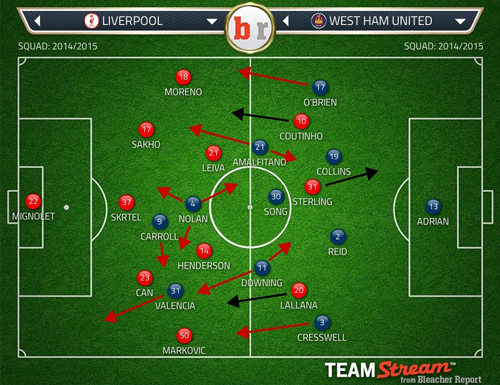By Mihail Vladimirov.
SUMMARY:
- West Ham made a proactive start – Allardyce’s midfield unit tried to match Liverpool’s
- West Ham targeted Liverpool’s right-hand side
- Sterling became isolated as Lallana and Coutinho were forced into helping out defensively
- Liverpool gradually started to see more of the ball as West Ham’s pressing faded
- West Ham switched to a very solid 4-3-1-2 formation following injury to Collins
- Liverpool were struggling to open up West Ham’s well-organised defence
- Liverpool lacked diverse attacking movement, a persistent problem in the past month or so
- Markovic’s chance right on half-time was Liverpool’s best chance of the half
- Can and Skrtel swapped positions
- Liverpool mixed their attacking more, going down the right as well as the left
- Immediately after conceding the first goal, Allardyce made a substitution – Nolan for Amalfitano –and reshuffled his team tactically with the Hammers going 4-2-3-1
- the visitors looked sluggish on the ball and especially without it, so it was easy for Liverpool to defend against their half-hearted attacking attempts
- Cole was a like-for-like replacement for Carroll, and still West Ham struggled and failed to test Mignolet
- the way West Ham played defensively once going a goal down was perfect for Liverpool
- just after the second goal West Ham went down to ten men following Reid’s injury, as Allardyce had already used all his subs
- Sturridge’s individual quality shone through, and Liverpool’s second goal killed the game off
- Liverpool saw out the game comfortably
For this game Rodgers didn’t rotate the side following the exhausting second leg game with Chelsea in midweek, the only change being enforced with Gerrard taken out of the squad as a precaution and Lallana coming into his place within the now customary 3-4-2-1 shape.
The big news was Sturridge’s return – he started on the bench but came on later in the second half to score the second goal and seal the win for the Reds.
On the opposite side, Allardyce didn’t have any fitness-related issues as his team had the whole week to rest and prepare for this game. The Hammers, however, had something of an injury crisis at the back with no fewer than four defenders doubtful for the game – centre-backs Tomkins and Collins and right-backs Jenkinson and O’Brien. Eventually Tomkins and Jenkinson sat out the game with Collins and O’Brien just passed fit to start the game.
West Ham start proactively, keep the game in Liverpool’s half
The main talking point was how both teams would approach the game, given the supposed difference in the fitness and freshness levels. Eventually this didn’t prove a decisive factor, given West Ham’s injuries before and during the game and the absence of important players such as Diafra Sakho and Cheikhou Kouyate. This largely took any advantage West Ham might have had in terms of nullifying Liverpool’s strengths and exposing their weaknesses in different periods of the game.
The rest of this analysis is for Subscribers only.
[ttt-subscribe-article]
